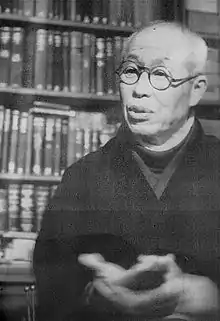Kanzō Uchiyama
Kanzō Uchiyama (内山 完造, Uchiyama Kanzō, January 11, 1885 – September 21, 1959) was the proprietor of the Uchiyama Bookstore, whose frequent visitors were both Chinese and Japanese intellectuals before World War II. Uchiyama was a Christian.
Kanzō Uchiyama | |
|---|---|
 Kanzō Uchiyama, 1953 | |
| Born | January 11, 1885. |
| Died | September 21, 1959 (aged 74) |
| Nationality | Japanese |
| Occupation | Proprietor of the Uchiyama Bookstore |
| Known for | Frequent visitors from both Chinese and Japanese intellectuals before World War II |
Early life
Kanzo Uchiyama was born in 1885, in the village of Yoshii in Shitsuki District, Okayama. At the age of 12, he was sent out for his apprenticeship to Osaka. He worked for 10 years for a merchant family in Kyoto.[1] At the age of 27, Uchiyama became a Christian.[2]
Shanghai and the Uchiyama Bookstore
At age 28, Kanzo moved to Shanghai, along with his wife Miki, as the overseas representative of Daigaku Megusuri Santendo (a pharmaceutical company).[1] He established his bookstore in 1917 on North Sichuan Road. He changed the location of the bookstore to the International Settlement in Hongkou.[3]
His store was frequented by Chinese and Japanese intellectuals, such as Lu Xun, Guo Moruo, Jun'ichirō Tanizaki, Sato Haruo and Hayashi Fumiko.[1] Tian Han,[4] and Chen Duxiu.[5]
By 1932, Uchiyama had become the sole publisher of Lu Xun's works.[6]
Later years
His wife, Miki, died in 1945.[7] The bookstore was closed down the same year.[8] Uchiyama returned to Japan in 1945.[9] After the war, he became the first head of the Japan-China Friendship Association.[1]
Kanzo became a friend of Wataru Kaji, subsequently receiving a will and testament following Kaji's abduction by the Canon Agency and attempted suicide.[10]
Kanzo is buried in the Wanguo Cemetery.[11]
See also
References
- "Historical Figures - Ibara city office". City.ibara.okayama.jp. Archived from the original on 2015-09-23. Retrieved 2014-02-05.
- Paul Scott. Uchiyama Kanzo: A Case Study in Sino-Japanese Interaction (PDF). Kansai University of Foreign Studies. p. 51.
- "Japanese Visions of Lu Xun in the Light of the Magic Lantern Incident". JapanFocus. Retrieved 2014-02-05.
- Paul Scott. Uchiyama Kanzo: A Case Study in Sino-Japanese Interaction (PDF). Kansai University of Foreign Studies. pp. 53–54.
- Beyond Brushtalk: Sino-Japanese Literary Exchange in the Interwar Period By Christopher T. Keaveney Page 41
- "A writer's shadow / Article-that's Shanghai-Urbanatomy Media". Old.thatsmags.com. Archived from the original on 2014-02-22. Retrieved 2014-02-05.
- "Metapress | A Fast Growing Resource for Young Entrepreneurs".
- "Lu Xun". Bekkoame.ne.jp. 1936-10-18. Retrieved 2014-02-08.
- Beyond Brushtalk: Sino-Japanese Literary Exchange in the Interwar Period By Christopher T. Keaveney Page 36
- Esselstrom, Erik, From Wartime Friend to Cold War Fiend: The Abduction of Kaji Wataru and U.S.-Japan Relations at Occupation's End, Journal of Cold War Studies
- "Red Tour Around China". English.cri.cn. Archived from the original on February 4, 2014. Retrieved 2014-02-05.
Further reading
- Christopher T. Keaveney, Beyond Brushtalk: Sino-Japanese Literary Exchange in the Interwar Period, Hong Kong University Press, 2009, pages 41-43
- Naoko Kato, Kaleidoscope: The Uchiyama Bookstore and its Sino-Japanese Visionaries, Hong Kong: Earnshaw Books, 2022.